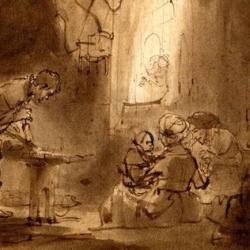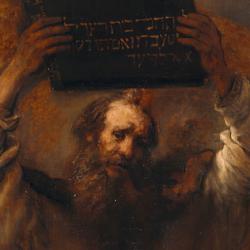Yesterday, I heard a highly stimulating sermon on gnat theology (Exodus 8:16-18) from my friend, Pastor David Deutsch of Grace Reformed Church in Camarillo, California.
Gnats arise from dust; dust is cursed, a symbol of death. From that association, David drew the inference that gnats on man and beast is a figure of the spread of death. Gnats are flying decay, death gone mobile.
Because of the gnat plague, everything is clothed in death, covered with dust in insect form, as if mourning the dead. And David pointed out that this included the Egyptian priests who ministered to the Egyptian gods (which Israel also worshiped).
Priests covered with gnats, or gnat-bites, would be too contaminated to carry out their work in Egyptian temples. The gnat plague didn’t attack a particular Egyptian gnat-deity, as the frog plague mocked Egyptian worship of frogs and the Nile plague attacked Egyptian worship of the Nile. Instead, the gnat plague was an assault on all the gods of Egypt, insofar as it interrupted the liturgical service that kept the gods happen so they could keep Israel happy.
That linkage is strengthened when we recall that gnats, as swarming things, were created on Day 5. Swarming things form into clouds, and clouds are associated with garments. Throughout Exodus, tabernacle curtains and priestly robes are associated with Day 5. The gnats covering man and beast thus form a clothing of death, an anti-priestly garment.
The fact that the gnats rise from the dust not only links to the curse but to Adam’s original creation from dust (Genesis 2:7) and Yahweh’s promise that He would raise an Adamic nation as numerous as dust from the dry ground of Abram (Genesis 13:16). Israel herself multiplied to “fill” the land of Egypt (Exodus 1:7, 12), swarming over the earth and alarming Pharaoh enough to take severe population control measures. It doesn’t work. Instead, Israel becomes living, flying, biting dust, and gnaws on Pharaoh.
The sermon also put me in mind of Revelation 9, where an angel opens the abyss and lest out creatures that resemble locusts with scorpion tails. That passage clearly links to the plague of locusts in Exodus, but it might also be a riff on the plague of gnats. The locorpions rise from the ground, like the gnats, they cause pain until men seek death and cannot find it. The locorpions are a demonic swarm of locusts, also a swarm of very large gnats. And they too cover everything with death, though without offering the relative relief that death brings.














